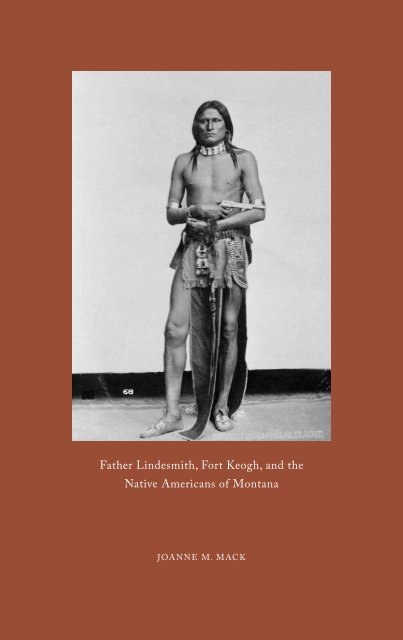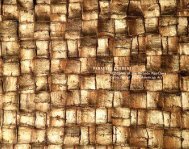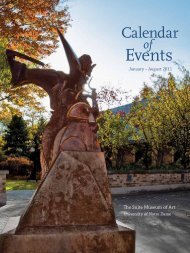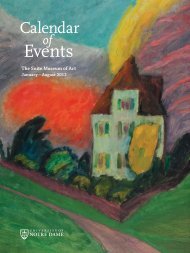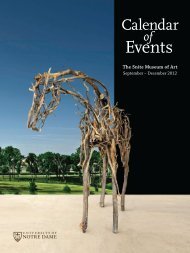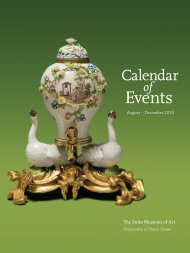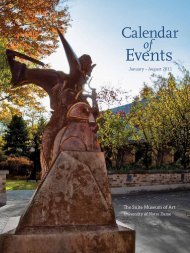HISTORY INTO ART AND ANTHROPOLOGY - Snite Museum of Art ...
HISTORY INTO ART AND ANTHROPOLOGY - Snite Museum of Art ...
HISTORY INTO ART AND ANTHROPOLOGY - Snite Museum of Art ...
Create successful ePaper yourself
Turn your PDF publications into a flip-book with our unique Google optimized e-Paper software.
Father Lindesmith, Fort Keogh, and the<br />
Native Americans <strong>of</strong> Montana<br />
JOANNE M. MACK<br />
Father Lindesmith carried to the West certain widely accepted stereotypes about<br />
Indians. During his eleven years at Fort Keogh, however, he changed his mind<br />
regarding at least some <strong>of</strong> them. When he was born—in Ohio, in 1827—the Indian<br />
wars fought in the Midwest and Southeast were ending, and, in the period <strong>of</strong> his<br />
childhood, many tribes and bands were being removed to the Southern Plains and<br />
prairie. Having grown up hearing stories about raids and battles, he quite understandably<br />
was fearful <strong>of</strong> Indians. Even as a fifty-three-year-old man traveling in the<br />
West for the first time, he accepted the dual image <strong>of</strong> Indians—as primitive and<br />
ferocious and as romantic noble savages—that had been prevalent and popular since<br />
Columbus. 1 By the time he left Fort Keogh, in 1891, he regarded Native Americans<br />
somewhat differently, and now saw them as being <strong>of</strong> two opposite types: the good<br />
Indian and the bad Indian. 2 Accordingly, good Indians attempted to lead a more<br />
civilized life; they raised crops and livestock, sent their children to school, and<br />
became Christians. Bad Indians, on the other hand, stole, killed Euro-Americans<br />
when confronted, and seemed uninterested in farming, ranching, sending their<br />
children to schools, or converting to Christianity.<br />
Lindesmith’s attitudes and impressions no doubt evolved due to his frequent<br />
encounters with Native American scouts and their families at Fort Keogh, with the<br />
Lakota bands held temporarily at the fort, with Crow scouts, and through interactions<br />
with other tribes on his travels. During the years he was stationed at the<br />
fort, many bands <strong>of</strong> Lakota and Cheyenne were kept on the Fort Keogh Military<br />
Reservation after they surrendered, because Brigadier General Nelson A. Miles,<br />
the fort’s commander, felt the U.S. Army could better care for them than could the<br />
Department <strong>of</strong> the Interior. 3 At times, as many as two thousand captured Native<br />
Americans camped at the fort—approximately fifteen hundred Lakota and five<br />
hundred Cheyenne; in June 1881 the Lakota were removed to Standing Rock. 4<br />
Father Lindesmith’s admiration for soldiers and, by extension, for the scouts at Fort<br />
Keogh and at Fort Custer on the Crow Reservation, also influenced his interactions<br />
with and beliefs about Native Americans. 5 Friendships among some soldiers<br />
and Native Americans were not unusual. 6 In addition, even though the scouts and<br />
their families camped some distance south <strong>of</strong> the main garrison, General Miles<br />
allowed them free run <strong>of</strong> the fort, and they spent their wages in the post store.<br />
When Lieutenant Edward W. Casey took command <strong>of</strong> the scouts, he had them<br />
build a cantonment <strong>of</strong> their own. 7 Lindesmith was present throughout this period,<br />
so he had easy access to the Native Americans who came into the garrison area.<br />
Furthermore, he could ride out to the camps, particularly those <strong>of</strong> the Cheyenne,<br />
who settled on the edge <strong>of</strong> the fort’s reservation and later were assigned to the<br />
Tongue River Reservation, not far from Fort Keogh. He also was able to visit the<br />
scouts’ camps and, later, their cantonment.<br />
opposite: Wolf Voice, Cheyenne Warrior in War Costume, 1878<br />
Glenbow Archives. Image number: NA-207-29<br />
68 69


